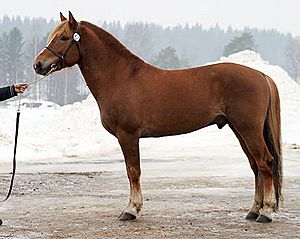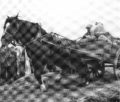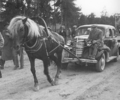Quick facts for kids
Finnhorse

Finnhorse stallion, trotter section
|
| Distinguishing features |
Dry and strongly muscled, with strong bone and good hooves. Most often of chestnut colour. |
| Alternative names |
Finnish Horse, Finnish Universal, Suokki |
| Country of origin |
Finland |
| Breed standards |
| Hippos |
Breed standards |
| Horse (Equus ferus caballus) |
The Finnhorse or Finnish Horse is a horse breed developed in Finland. The Finnhorse is the national horse breed of Finland. It is suitable both for riding and to pull vehicles in races and as a workhorse.
Studbook of Finnhorses was founded 1907. The horse is 156 cm high. It has many colours, but the main colours are brown and black. The Finnhorse has often white markings on the face and the legs.
Images for kids
-
A founding sire, Jaakko (Tt 118), photographed in 1882
-
Black is one of the rarest Finnhorse colours.
-
Draught-type stallion Murron-Ryhti 3531 pulling a stone cart at a pulling competition in the 1930s, exhibiting the typical low, effective pulling stature of the breed.
-
Murto 2306 (b. 1917) was ahead of his time both in speed and type. His light, "foreign" looks combined with flashy markings almost kept him out of the studbook, but once at stud he proved highly successful, and became exceedingly influential in the breed, especially through his son Eri-Aaroni.
-
Finnhorse stallion competing in dressage
-
Despite its small size, the pony-sized Finnhorse is not a pony, and possesses the same body proportion and movement as the larger sections.
-
Finnhorse stallion performing in the pulling test with a measuring car. His breeder is allowed to sit on the car, an exception to the rules. Car pulling was part of stallions' studbook evaluation from 1936 to 1970.
-
Finnish horses and a horse-drawn tram in Turku, 1890
-
Contrasting early types: A small, stocky roan Finnish horse from Karelian Isthmus, photographed in 1909. 12.3 hands (51 inches, 130 cm) high.
-
Contrasting early types: A more refined flaxen-maned chestnut Finnhorse from Central Finland, photographed in 1910. 14 hands (56 inches, 142 cm) high.
-
Historical re-enactment of early 20th century cavalry use of the Finnhorse. 1922 Ratsumieskilta ("Horseman Guild") uniform.
-
The Orlov trotter was one of the breeds widely used for crossbreeding the Finnish horse. Late 19th century drawing.
-
One of the Finnhorse founding sires, Kirppu tt 710, pulling an early sulky at full speed, c. 1890
-
A late experiment of crossbreeding: an estate's carriage horse in the early 20th century, presumably of a Thoroughbred mix.
-
Horseman towing a ski messenger returning from the front
-
Gelding Reipas, first horse in Finland to earn over one million Marks, was one of the harness racing stars that became a popular hero during the hard decline of the Finnhorse.
-
A Vyatka horse exhibiting an overall expression similar to the Finnhorse
-
Jumping a basic cross-rail
-
Harness racing has been the main use of the Finnhorse since the 1960s. In the lead is two-time winner of the Ravikuningatar title, I.P. Vipotiina, during her August 2010 Finnish record run.
-
The Finnhorse's popularity as a breed for recreational riding in Finland has been increasing since the late 20th century.
-
A Finnish family making hay in 1954. The Finnhorse's mild nature makes the breed a valuable companion in agricultural work as well as a therapy mount.
See also
 In Spanish: Caballo finlandés para niños
In Spanish: Caballo finlandés para niños

 In Spanish: Caballo finlandés para niños
In Spanish: Caballo finlandés para niños





















